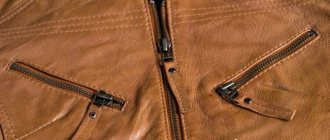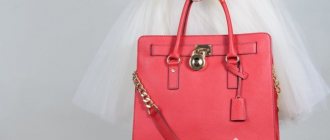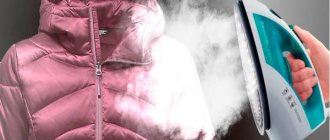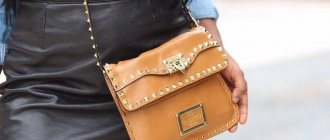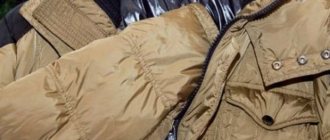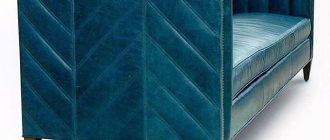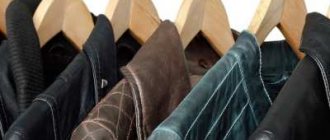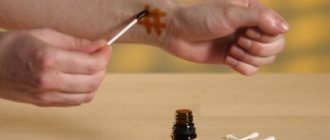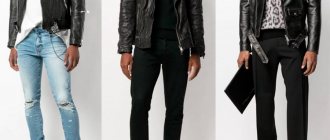With the arrival of autumn and the onset of the first cold weather, many of us reached into closets and onto the mezzanine for our favorite leather jacket. Despite all the plasticity of leather and its wrinkle-resistant properties, long-term storage folded or in a cramped closet sometimes causes folds and creases to form in certain places. A reasonable question arises: how to iron a leather jacket and do it correctly without damaging a good thing?
Leather is a very practical and comfortable material. With proper care, it does not lose its presentable appearance for many years.
If you are faced with minor bruises, then the easiest way to smooth out a leather jacket at home is in a natural (spontaneous) way. This is the safest method, effective for both genuine leather and leatherette products.
Oil treatment
An effective way to smooth out a jacket is to treat the affected areas with nut oil.
Suitable for leather of any thickness. Places of creases and bruises are carefully treated with a cotton swab or sponge soaked in oil. The surface is wetted 3-4 times with short breaks. The fatty acids contained in the oil penetrate into the material and help soften it. After treatment, the jacket should be hung on hangers and left in a well-ventilated area for several hours.
Remember that the jacket must be clean before this procedure. Dirt can be absorbed into the material along with oil and will be difficult to get rid of even with the help of dry cleaning.
If nut butter is too expensive or difficult to obtain, you can substitute castor oil, petroleum jelly, or glycerin. Treating the jacket with these products helps moisturize the skin and is also used for preventive purposes to prevent drying out.
Gentle effect
Leather clothing is a delicate material and you should start with easy methods.
- You can straighten a jacket that has been stored folded by placing it on hangers for several days, shaking it thoroughly before doing so. It is better if the room is humid. During this time, the jacket will sag and its original appearance should be restored. However, this method is effective only for soft and thin skin, and with minor wrinkles.
- The method is suitable for a jacket and boots. Place clothes on hangers and button them up, and fill boots with old packaging, crumpled newspapers or wallpaper. Moisten the skin thoroughly with water from a spray bottle. Leave for an hour so that the material begins to straighten on its own due to moisture. If necessary, repeat the procedure 2-3 times until the bruise disappears.
- Sometimes lubricating problem areas with Vaseline, castor or nut oil helps. The layer should be thick. Do not rub the product until dry. Duration of exposure is 2-3 hours. The material gradually softens and the folds move away. Finally, remove the residue with a napkin, otherwise the surface will remain sticky and matte. Polish with a piece of woolen cloth. The oil also helps restore elasticity to clothes.
- A solution of pharmaceutical glycerin can rid a leather bag of creases after storage. It is ideal for fair skin that may be prone to oil stains. The product is mixed with water, and then the surface is treated with a spray bottle. The bag should be stuffed tightly and hung until the evening.
- To smooth leather products, the industry produces moisturizers with a spray for convenient use. Lay the jacket on the table and straighten the area to be treated. Shake the bottle and spray from a distance of 20 cm. Rub the composition over the skin with a soft, dry cloth until it is absorbed. Do not leave it on the surface until it dries naturally. After processing is completed, hang the clothes on hangers and fasten them. It will take several hours for it to sag.
How to return leatherette items to their original shape
After purchasing a leatherette bag or jacket, you need to know how to iron it. The most difficult thing to remove is old creases that have already formed cracks on the fold. And the thicker the material, the more noticeable the problem areas.
Advice. Before smoothing artificial leather, read the label information. There may be some methods that are prohibited on your bag or jacket, such as using an iron.
It is possible to smooth leatherette using proven methods:
Advice. Before you begin ironing the entire garment, try doing it using your chosen method on a small, inconspicuous area of the fabric, especially before ironing. Only after you are sure that the procedure is safe can you iron the entire item.
We use steam
You can smooth out a wrinkled leather jacket using an iron with a steam generator or a steamer. This method successfully copes with creases on thick leather products.
Products impregnated with a moisture-repellent composition or not recommended for steaming cannot be treated with steam. Information can be found on the product tag.
The fur from the collar must first be unfastened. The jacket needs to be hung on a hanger. Steaming is performed at a distance of at least 10 centimeters. Use smooth movements to move the iron or steamer along the bruises. It is recommended to stay in one place for no more than 3 seconds. It is advisable to steam only problem areas without subjecting the entire product to heat treatment.
If you don’t have special equipment, you can place a hanger with a jacket in the bathroom above a container of hot water. The entire surface of the product will be treated and smoothed with steam. The procedure must be continued for 30 minutes. Moisture accumulated on the skin must be periodically removed with a dry cloth. Next, the jacket is hung out for several hours in a ventilated place. Suitable for different skin thicknesses.
Smoothing using household appliances
If a genuine leather item is not wrinkled, then you should not expose it to heat unnecessarily.
The soft leather of trousers, jackets or skirts may even become smooth under the weight of the item itself if left hanging for a few days.
Is it possible to iron wrinkled leather items with an iron?
You can iron wrinkled leather clothes using a regular iron. But it is necessary to take into account all the features of natural leather.
Rules for using the iron:
It is recommended to iron products from the inside out.- Smoothing is done through additional fabric with an unexpressed texture. Because otherwise, the pattern from this fabric may be imprinted on the skin when using an iron.
- The steam function on the iron must be turned off.
- Set the temperature on the iron to minimum, “silk” position.
- The area you just ironed must cool down before moving on to the next one.
- The ironed item should be hung loose for 30-60 minutes so that the shape is fixed and the item cools down.
- When ironing, the presence of overhead and decorative elements must be taken into account. It is necessary to ensure that, for example, the fringe of a leather jacket is not exposed to the iron, etc.
Do not allow direct contact of natural leather with a heated iron!
The video will show you how to iron natural and artificial leather:
Steaming at home
In order to steam a leather product, it must be positioned vertically . This requirement applies not only to raincoats and jackets, but also to dresses, trousers, and skirts.
Blazers, raincoats, dresses, vests and jackets are worn on hangers. Pants, shorts and skirts are secured to special trempels so that the item hangs freely.
The steaming process depends on the density of the leather and how much and in what places it is wrinkled.
Devices that can be used for steaming:
- steam generator;
- steamer;
- iron with vertical steam function.
Features of steaming leather clothing:
Steam can be used to treat only jammed areas or the entire item.- Begin processing with small parts, gradually moving to large ones.
- The stream of steam cannot be held in one place for a long time - no more than a couple of seconds.
- The distance from which steaming is carried out should not be less than 15-20 cm.
- The intensity of exposure should take into account the density of natural leather. Excessive exposure may damage delicate material.
- Steaming is best done from the inside out.
How to steam natural leather, video tips:
Items that are difficult to smooth out
How to remove creases from a leather jacket collar
You can, of course, take the item to a leather workshop. In a day, or even two, the jacket will return home with a smoothed collar. Many sites advise ironing this item of clothing through 2 layers of gauze. But as it turned out earlier, you can’t do this if you don’t want to become the owner of a strange design on your jacket. And here another wise recipe from our grandmothers comes to the rescue:
- Brew starch, the ratio of water and starch is 1:1. The consistency should resemble jelly;
- pour the cooled starch into warm water;
- soak a cotton pad in the solution;
- without squeezing, go over the skin creases;
- dry without exposing to direct sunlight;
- iron slightly damp, covered with a smooth cloth.
Liquid starch straightens wrinkles on the collar
Skin with defects is smoothed out carefully
After all, scratches from a cat’s paws can “creep” further, a small inconspicuous hole can melt. In fact, there are, of course, many more defects. The product must be inspected before smoothing. Torn areas will need to be stitched up to prevent the edges from curling under the influence of humidity and temperature. If glue spots or paint blots are visible on the skin, under no circumstances should you use an iron or hair dryer.
You can use castor oil. A small amount of it is applied to a sponge and treated the skin. To prevent oil stains from forming on white skin, after treating with castor oil, wipe the area with a soft soda solution: 1 teaspoon of soda per 100 ml of water. Then you need to walk over the surface with a smooth cloth. But the most gentle smoothing options would still be steaming in the bathroom or a leather workshop.
A winter leather jacket should remain comfortable
Most often, the filler and insulation nowadays is padding polyester or synthetic padding. True, natural down should not be excluded either. In addition to the fact that leather itself is a delicate material, it is necessary to exclude mechanical effects on the insulation. It cannot be placed under a press, because the insulation layer gradually becomes thinner. This causes the jacket to become less warm. If fur is used as insulation, you need to determine whether it is sewn tightly into the jacket. No - then you definitely need to unfasten it. In any case, clothes must be hung on a hanger and fastened. After all, according to experts, it is the steam generator that will be able to level out deep, complex creases formed due to the thick layer of insulation inside. If it was not possible to completely smooth out the folds, you should seek help from specialists.
The methods described in the article are the most effective at home. In addition, they are budget-friendly, which is nice for any housewife. If traces of bends or folds are slightly visible after applying the tips, it’s up to you to decide: try several methods in turn or take the item to the dry cleaner.
Dry ironing
This method can damage the skin if used incorrectly, so strictly adhere to the following rules:
- The iron temperature should be minimal;
- Ironing can only be done through a pad of thick fabric or parchment;
- You can iron a leather jacket only from the front side. The reverse side can only be ironed if there is no lining;
- Do not use water or steam during the treatment process;
- The iron is applied to the problem area for no more than 2 seconds and immediately removed;
- You can change ironing areas only after the already processed ones have cooled;
- If an area of thick skin is not smoothed out the first time, the procedure must be repeated;
- In hard-to-reach places (sleeves, shoulders) you need to use a stand for ironing sleeves.
The fabric you use for ironing as a pad should be smooth and have a fine texture. Large textures or embossing on the fabric will be imprinted on the leather.
By dry ironing
The iron successfully straightens smooth surfaces on leather clothing without trim or folds. On an inconspicuous area, first test the skin's reaction to heat. If the color changes, you need to check whether it returns after cooling. If the color is not restored, ironing is prohibited.
When performing the procedure, the following conditions must be met:
- Processing should be done from the front side. Ironing from the inside out is allowed only if there is no lining.
- Set the heating temperature to minimum or to the “silk” position.
- Be sure to use a pad to avoid direct contact with skin. Wrapping paper, a thin cloth with a flat surface, or baking paper are suitable. Gauze cannot be used - it leaves a mesh pattern.
Important! When ironing, wrinkled leather should not be exposed to steam.
- In problem areas, the iron should be pressed for a few seconds.
- You won’t be able to stroke the product with your usual movements, because they can stretch the skin.
- The operation is performed slowly, with a sequential transition from one area to another.
- In a heated area, you can slightly stretch the skin with your fingers. As it cools down, it will straighten out.
- You need to make sure that the areas of the heated material do not touch, and iron the sleeves on a separate stand or insert rollers from a folded towel into them.
- Rotate or move leather clothing only after it has completely cooled down.
- Iron small parts separately on a small stand.
- Imprints from seams and pocket flaps are ironed through a damp cloth. To do this, you need to switch the iron to the next position.
Advice. Foam from beaten egg yolk will help restore gloss to the skin after smoothing with an iron. It is applied to the surface with a cotton swab or cloth.
When all the folds are straightened, leave the skin to cool. After this, shake the product and place it on a hanger. If it is necessary to iron from the inside out, then the lining is trimmed and then sewn with hidden stitches.
Can I iron it?
An iron is used if you need to iron a collar on a jacket, seams on trousers, skirts, or a dress. To eliminate a crease in the collar area:
- prepare a thick mixture of potato starch and water;
- applied to the fold;
- iron with a lukewarm iron through white fabric folded in 2-3 layers.
The procedure is repeated until the starch dries. In this way, small and large folds are smoothed out.
When ironing the product, the steam generation function is turned off. The temperature regulator is set to minimum. The thing is laid out on the table. Inspect and wipe off contaminated areas with a damp cloth. Iron the leather product from the front side through white cotton fabric folded in 2 layers.
A special stand is used for the sleeves. Not all leather items can be ironed. Do not use a hot iron on parts of jackets, skirts, and trousers decorated with metal elements. It can damage decorative elements. The iron is not used if the material is embossed or laser processed.
Storage rules
In order for leather products to retain their original appearance for a long time, it is recommended to adhere to the following rules.
The jacket should be stored on hangers and hung on them even for a short period of time. The length of the hangers should match the width of the shoulders.
A wet jacket must be dried before placing it in the closet. A jacket placed in a closet should not be squeezed by other things.
Long-term storage is carried out in special ventilated cases to prevent contact with other products.
Remember that storing a leather jacket on a hook or folded leads to the formation of creases and dents.
With the help of these tips, Victoria was able to not only smooth out her jacket, but also taught her husband to hang it on hangers. More than a month has passed since then, and his clothes still look great.
How to increase the service life of leatherette
Strict adherence to the rules of operation, storage and cleaning will help extend the life of items made of leatherette. Many of them are indicated by the manufacturer on the label. Items made from this material should not be stored folded, but carefully hung to avoid the formation of folds and unevenness.
Drying such clothes with heating electrical appliances can lead to deformation and cracking of the surface. For cleaning, compositions and substances without chemically aggressive components should be used. Leatherette is an economical, comfortable and practical material. But it is capricious in operation and maintenance.
What should you not do?
What some owners of leather jackets can come up with to iron them at home.
Under no circumstances should this issue be resolved using:
- hairdryer;
- processing the material with hot water;
- stretching the folds with your hands.
All these methods will not give the desired result, but they will easily ruin your favorite jacket.
The hair dryer dries out the skin. It makes the fabric stiff, but the wrinkles will not go away.
Hot water should not be used because the fabric may become deformed and change color due to high temperatures. But the creases and folds will remain.
You should also not stretch the skin with your hands. The fabric is injured and cracks may appear on it, which can only be masked with special paint or by contacting a dry cleaning studio.
What not to do
Many people use the old fashioned way to remove creases and wrinkles from clothes that are ineffective. At best, they do not give the desired result; at worst, they worsen the appearance of the product.
Let it sag
If you need an item urgently, then this is not the best option. It is not suitable for products made of thick, rough leather. A jacket, dress, or raincoat needs to hang on hangers for several days for shallow, fresh creases to disappear.
Smoothing with hot air
It is not recommended to use a hairdryer on folds. A blast of hot air will not smooth them out. It will dry out natural leather, making it rough and tough.
Using hot water
It is not recommended to immerse things made of genuine leather in hot water. With prolonged exposure to hot liquid, they lose elasticity, color, and shape.
Stretching folds
When you stretch the folds of the skin with your hands, the item becomes deformed. The shape is not completely restored, convex areas appear.
Breaking in
A long walk in the rain cannot restore your skin to its former smoothness. Exposure to damp air softens it, but only small creases are smoothed out.
General information
This thing crumples mainly due to the wrong method of storage or transportation.
The longest way is to let the jacket hang on the hanger, but the room should be with a high level of humidity, for example, a closed room with a filled bathtub. The jacket is hung from above, avoiding direct contact with water. In this case, it will take at least overnight to straighten the leather material. And you can’t put it on right away either to avoid deformation. You need to give the jacket time to cool and dry.
Many people think of using hot air (from an iron or hair dryer) to straighten folds and creases. This method is good for almost any other clothing, but not for leather items.
IMPORTANT!
The flow of hot air will dry out the skin excessively, making it rough and inelastic, which can lead to the formation of cracks and other defects.
Leveling with glycerin
When artificial leather needs to be smoothed frequently, pharmaceutical glycerin is suitable for these purposes. Apply a small amount to undyed cotton rags. Treat the dented area with the product 2-3 times, and then the entire front surface. Hang the clothes on a trempel and place them in the room so that there is no contact with other clothes or objects. Leave it like this until completely dry.
Important! A number of synthetic leather materials are sensitive to glycerin. Before use, it is necessary to experiment on a sample to check whether the color and properties change.
How to iron a pleated dress
The joy of buying a pleated dress lasts until the first wash: forming and ironing each fold again, you can simply go crazy. That's why there are a couple of tricks.
How can you make your task easier?
- Before washing, secure the folds by stitching them around the circumference when folded. If the dress with pleats is long, then it is better to make several such lines. So, by placing the product on the ironing board, you can work with it in the same way as with a regular linen, and you will not have to iron out the folds.
- When washing such dresses, add conditioner to avoid unnecessary creases as much as possible.
- To ensure that the factory pleating lasts as long as possible, never wring out or machine dry such dresses, or dry them by throwing them over a clothesline.
- Such dresses are dried, again, immediately on a hanger or secured with clothespins at the seams near the neck.
Is it possible to use steaming with such dresses? Even necessary! This will make the folds look even more distinct.
Various materials
The ironing method and choice of temperature also depend on the material from which the pleated skirt is made:
- silk is ironed only from the wrong side without using water, which can leave stains on the product;
- chiffon can be moistened with water, but the lining should be ironed separately;
- For knitwear, ironing through double gauze using steam is suitable;
- Silk knitwear, which combines features of both silk and knitwear, should be ironed only when absolutely necessary and only from the inside out through a damp cloth.
By following the rules for ironing skirts made of different fabrics, you can return your favorite wardrobe item to a neat appearance without damaging its shape.
To do this, you need to be careful and use only proven products.
In order to most effectively smooth out wrinkles on leather clothing with an iron, you need to determine what type it is. Leather products can be made from the following types of material:
- Genuine Leather;
- artificial (leatherette);
- eco leather.
If you don't know what type of leather your skirt is made of, look at the back of it. The reverse side of the natural material will be velvety and fleecy. Faux leather and eco-leather, which is a type of artificial leather, have a woven base on the inside. You can see the weave of threads on the back of the product.
For all types of material, the same smoothing methods can be used with some differences. It is better to iron a skirt or dress made of genuine leather from the front side through paper or cotton material. Faux leather, which has a woven base, can be ironed from the inside out without using fabric.
If the dress or skirt has a stitched lining that does not allow you to see the inside, you need to iron the item from the front side through a thin fabric. You can also use other ways to straighten wrinkles at home.
In what cases may it be necessary to stroke the skin? These may be the following factors:
- The presence of folds and creases on the surface of the skin as a result of improper storage or other reasons.
- Elongated areas appear on genuine leather products during wear, for example, on the elbows or buttocks. Things made from artificial materials are not susceptible to this.
- The leather item has become deformed as a result of improper care or for another reason.
The quality of the product also matters. The thinner and better the material from which the product is made, the easier and faster you can iron it. Thin natural leather is easier to process than hard leatherette.
How to Avoid Creases
Artificial leather is more susceptible to environmental influences than natural material. When purchasing items made from leatherette, you should take into account that caring for them has its own characteristics:
- You cannot use sealed bags for storing or transporting leatherette items.
- Do not fold jackets and bags even twice, but let them lie flat.
- Direct contact of skin with a hot iron is strictly prohibited.
- Even 1-2 hours near sources of hot dry air is enough for the material to crack and wrinkle.
- When new creases form, try to remove them immediately.
- Buy leatherette clothing by size. Excess material, as well as overstretched leather, can form folds.
- Covers for car interiors made of leatherette should be as tight as possible. This advice also applies to other things made of leather: photo albums, wallets, various interior elements.
When one season gives way to another, many of us put warm clothes in the far corner of the closet. They are placed on shelves and compacted, which leads to the appearance of folds, creases and visible traces of storage on outerwear.
But as soon as the wind blows and it gets cooler, their favorite things are released from captivity, wrinkled and unkempt.
It is possible to quickly solve such a problem using several methods, using available tools
, which can be found in every housewife’s home. Similar methods and step-by-step instructions will be given in the article below.
Properly ironing a jacket, coat or bag made of leatherette means extending their service life and saving yourself from additional expenses. Things made from genuine leather are more expensive and more difficult to care for and wear, while leather substitutes cost less and are more durable, so they are deservedly popular.
After taking the item out, simply hang it on a hanger. Give her the opportunity to deal with it on her own, without your help.
If within a few days the folds and creases on the leatherette jacket have not gone away, then you should move on to more drastic measures - applying temperature or hot steam.
Ironing
Using this method, the main condition will be maintaining the temperature (not higher than 30 degrees),
turning off the steam function on the iron, minimal pressure on the device and ironing the item turned inside out.
You should also understand that if done incorrectly, the jacket can be irreparably damaged.
Actions must be clear, accurate and step-by-step:
- Set the iron to delicate ironing mode and turn off the steam function. To avoid deformation of the leather under the influence of heat, check the correct temperature using the tip of the iron sole, on the wrong side of the item, where it is not visible.
- Turn the jacket with the lining facing up. First, smooth out any visible unevenness with your hands.
- Place a piece of smooth cotton fabric over the areas where the leatherettes come into contact, as sticking may occur under the influence of temperature. Be sure to do this when the lining material is thin or missing.
- Turn it back inside out.
Hang on a hanger, adding volume using filler from disposable bags or strands of towels. Another option is to put an ironed jacket on yourself and walk in it for about an hour so that it remembers the contours of your body.
Steaming
A more gentle and safe way. In order for everything to work out well, you need to do the following:
- Find soft hangers that fit the size, roll up rolls of terry towels and insert them into the sleeves.
- For the process, take a steamer or iron (set the vertical steaming mode).
- We process small areas, at a distance of 10-15 cm from the item.
- We act for 5-10 seconds on those places where there are irregularities.
- Leave it alone for 30 minutes.
Hairdryer - ironing with hot air
If you are afraid to use an iron and do not have a steamer, take a hair dryer to help.
Additionally, for the procedure, prepare a wet handkerchief or piece of fabric, a blanket.
- Roll up the blanket and put it in your jacket.
- Cover the place where hot air comes out of the hair dryer with a piece of cloth.
- Turn on high mode. Blow the jacket at a distance of 20 cm.
- Leave the item to cool.
- Try again if not all areas are smoothed out.
Without the use of auxiliary means
You need to prepare for the onset of spring, take light outerwear out of the closets and put it in order.
Straightening out the folds of a leather jacket is the hardest thing to do. This material looks great, but it is not easy to care for.
If you are afraid to use an iron or steam cleaner, you can always straighten out the folds on a leather jacket without using auxiliary methods.
How to smooth natural leather:
- Remove the product from the cabinet and shake it well.
- Choose hangers, they should fit in size. A hanger that is too short will cause bulges to appear on the shoulders, while a hanger that is too long will cause bulges to appear on the sleeves.
- After hanging it on a hanger, you need to align the product and fasten it.
- It is necessary to hang clothes in a separate closet or away from other things so that the jacket does not come into contact with them. Otherwise, it will wrinkle even more.
Thus, in 2-3 days you can remove small unevenness, but you will not be able to remove strong creases on a leather jacket.
Another method of leveling without aids is to wet the surface with plain water from a spray bottle and put the outerwear on yourself or on the mannequin.
This method is faster. It is enough to walk around in clothes for 2–4 hours. The material will lie in shape and there will be no trace of folds left.
Useful tips and tricks
To prevent your skin from wrinkles, follow a few rules:
- Most importantly, do not fold your jacket, skirt or other leather item. If you don’t want dents and creases, hang it on a hanger that fits the size.
- Before putting the item in the closet, take everything out of the pockets and fasten the zippers and clasps.
- If the item has a belt, it is better to remove it and hang it on the bar of the hanger. Don't fold it! It can also wrinkle.
- A special cover will save you from dust, preferably made of natural fabrics so that it allows air to pass through well. In a synthetic case, the leather may oxidize and change color.
- A hanger with a leather item should hang freely in the closet.
- The cabinet, naturally, should be dry and away from the battery.
- It is not recommended to wash leather items. It’s better to take them to a dry cleaner, where the stains will be removed professionally.
Natural ways
To iron a leather jacket at home, you can use a simple method - a hanger. What should be done:
- Shake the product.
- Choose a hanger with wide shoulders and hang your jacket.
- Fasten the zippers and buttons.
- Smooth out with your hands.
- Hang it separately from other things; the product should not come into contact with the wall or cabinet.
In this condition, the product should hang for several days. The quantity depends on the quality of the material:
- For thin skin - up to 3 days.
- For dense material - from 2 weeks.
It is not recommended to hang a new leather jacket on a hook or put it in a closet. Use hangers or the back of a chair for storage.
If there are small creases, you can smooth out the leather on the jacket with normal wear. It is enough to walk around in outerwear for 2-4 hours. This method is effective for clothes after purchase.
To speed up the smoothing process, you can use Vaseline or nut butter. Using a soft cloth, apply the product to the wrinkled areas. The product must be saturated with oil. After which the leather jacket is taken to the balcony or open air for ventilation. This method not only smoothes the skin, but also softens the product.
Eco leather should level out
A huge number of things are now produced from eco-leather: jackets, cardigans, skirts. To form folds, just sit on a chair. But creases are unlikely to decorate clothes, which means you need to get rid of them. The sooner, the better.
Unlike skin that does not like water splashes, the artificial analogue is quite tolerant of such procedures. First, the item is turned inside out and placed on a hanger. Spray with warm (but not hot) water from a spray bottle. The lining is moistened evenly. After this, the eco-leather should dry. The wrinkles will smooth out.
The second method (folk) is used not only for eco-leather, but also for other artificial and natural analogues. The jacket is hung on a hanger with wide shoulders. You need to fasten all the locks and fasteners. A tap with boiling water opens in the bathroom. The jacket should be hung near the source of steam, but to prevent water from getting on the clothes. The item should remain in such a bath for about an hour. After which the eco-leather is thoroughly dried.
Ironing from the inside out
If a genuine leather jacket is ironed from the front side, then this number will not work here. The product must be turned inside out. But “ironing” will undoubtedly be needed. But you don’t have to worry about choosing fabric for it. Both smooth fabric and regular gauze will do. If it is cotton material, then it is not necessary to moisturize it. Then you should use the steam generator function built into the iron. Since eco-leather is still an artificial fabric, you need to choose an ironing program with a minimum temperature. For cotton - 140 degrees, for cotton with the addition of polyester, an even more gentle mode - 110 degrees. And steam effects on the material should be as short as possible.
The temperature when steaming eco-leather should be minimal
The folds will come apart under pressure
As a press you can take:
- books (a couple of encyclopedias)
- a container filled with water;
- a stack of magazines;
- brick packed in a plastic bag.
The eco-leather is straightened with your hands on a flat surface. After which you need to level the lining so that internal folds do not form. Cover with a smooth cloth to avoid marks on the skin. Place the press on top, carefully making sure that no new folds or bends appear. The item should be under pressure for 10–12 hours. After which the product must be hung on a hanger with wide hangers. In another day, clothes made from eco-leather will look like new.
They can be used as a press to smooth out the skin
Leatherette
Faux leather is very often chosen as a material for sewing clothes.
How to smooth it depends on the characteristics of the material and the method of its manufacture. Many methods suitable for natural leather are also suitable for artificial leather.
Processing should begin by studying the information on the label , including the composition and care rules. Artificial material can be ironed from the inside out, at a minimum temperature, by steaming.
Artificial material is less plastic, has worse breathability, and is rougher. Clothing made from artificial leather lasts less and loses its appearance faster.
At the same time, the requirements for storage conditions for these clothes are the same as for genuine leather.
Eliminating wrinkles in leatherette
Faux leather is popular, it looks no worse than real leather, but costs several times less. A variety of products are made from leather substitute: from handbags to raincoats. The basic ironing rules are the same for natural and artificial leather. In order not to spoil the item and achieve the desired result, you should follow the ironing recommendations.
- Only from the inside out. Under no circumstances (even through fabric) is it recommended to iron a jacket or other leatherette product from the outside. The upper part of the leatherette quickly melts, sticks to the sole of the iron, and lags behind the cotton lining.
- Fabric pad. The item must be turned inside out, and thick fabric must be placed between the front parts (it is recommended to put rolled towels into the sleeves). Otherwise, parts of the product may stick together under the influence of heat.
- Temperature conditions. Faux leather is often much thinner than genuine leather, so the temperature regime is set to a minimum. This will prevent the material from melting. When ironing, steam mode is not used. Faux leather can be steamed, but only from the reverse side.
Artificial leather products can be effectively straightened using alternative methods without the use of household appliances. Features of the use of skin substitute smoothing products are described in the table.
Table - Methods for smoothing leatherette products
| Means | Peculiarities |
| Water | — The product is sprayed with water from the reverse side; — to avoid streaks, use distilled water; — water is sprayed moderately so that it does not flow down the material; - creases are straightened with your hands |
| Glycerol | — Applied from the front side; — apply the product with a clean cotton rag; — wrinkled areas and creases are wiped; — quite a lot of glycerin is used (the material should shine) |
| Vinegar and conditioner | - A solution is prepared from equal parts - vinegar, water, fabric softener; - applied to the material from the outside using a spray bottle; - stains formed after drying are wiped with a damp, clean cloth |
After any procedures, the leatherette is left to “rest” in a straightened form on a hanger in a hanging position. The product should not be hung near heating appliances or in a draft.
